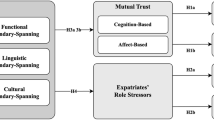Abstract
The study examined the effect of several personal and situational variables upon stayers' intention to leave, subsequent to the departure of a coworker. These effects were hypothesized to be mediated by the stayers' evaluation of outcomes of the departure. Police officers filled questionnaires prior to and within one month subsequent to turnover of a coworker. The theoretical model was tested via hierarchical multiple regression. Negative and positive evaluations were independent: They were differentially associated with the predictor variables and they varied in their effect upon the criterion measure. The mediation hypothesis was not supported; the negative evaluation of departure outcomes was indeed predicted by the independent variables but it was not associated with the intention to leave subsequent to a coworker's departure. Positive evaluation, on the other hand, was not predicted by the independent variables but was significantly and positively correlated with the criterion measure. Contrary to the hypothesis, stayers who perceive coworkers' departure as more positive show a stronger tendency to leave.
Similar content being viewed by others
REFERENCES
Andrews, F., & Whiney, S.B. (1976). Social indicators of well-being: American's perceptions of life quality. New York: Plenum.
Baron, R.M., & Kenny, D.A. (1986). The moderator-mediator variable distinction in social-psychological research: Conceptual, strategic, and statistical considerations. Journal of Personality and Social Psychology, 51, 1173–1182.
Becker, H.S. (1960). Notes on the concept of commitment. American Journal of Sociology, 97, 15–22.
Bradburn, N.M. (1969). The structure of psychological well-being. Chicago: Aldine.
Brockner, J. (1992). Managing the effects of layoffs on others. California Management Review (winter), 9–27.
Cook, J.D., Hepworth, S.J., Wall, T.D., & Warr, P.B. (Eds.). (1981). The experience of work. London: Academic Press.
Fiske, S.T., & Taylor, S.E. (1991). Social cognition (2nd Ed.). New York: McGraw Hill.
Fox, S., & Krausz, M. (1987). Correlates of relocation intention and emotional responses to an Israeli plant relocation. Journal of Occupational Behavior, 8, 325–338.
Gerhart, B. (1990). Voluntary turnover and alternative job opportunities. Journal of Applied Psychology, 75, 467–476.
Hackman, J.R., & Oldham, G.R. (1975). Development of the job diagnostic survey. Journal of Applied Psychology, 60, 159–170.
Judd, C.M., & Kenny, D.A. (1981). Process analysis: Estimating mediation in evaluation research. Evaluation research, 5, 602–619.
Kirchenbaum, A., & Weisberg, J. (1990). Predicting worker turnover: An assessment of intent on actual separation. Human relations, 43, 829–847.
Krackhardt, D., & Porter, L.W. (1985). When friends leave: A structural analysis of relationship between turnover and stayers attitudes. Administrative Science Quarterly, 30, 242–261.
Krackhardt, D., & Porter, L.W. (1986). The snowball effect: Turnover embedded in communication networks. Journal of Applied Psychology, 71, 50–55.
Krausz, M., Bizman, A., & Weiss, I. (1989). Causal attributions for turnover by supervisory and non-supervisory personnel. Social Behavior and Personality, 17, 93–101.
Krausz, M., Kedem, P., Tal, Z., & Amir, Y. (1992). Sex-role orientation and work adaptation of male nurses. Research in Nursing and Health, 15, 391–398.
Landy, F.L. (1989). Psychology of work behavior (Fourth edition). Pacific Grove, Calif.: Brooks/Cole Publishing Company.
Lee, T.W., & Mitchell, T.R. (1994). An alternative approach: The unfolding model of voluntary employee turnover. Academy of Management Review, 19, 51–89.
Mandler, G. Interruption (discrepancy) theory: Review and extensions. In: S. Fisher & C.L. Cooper (1990) (Eds.). On the move: The psychology of change and transition. Chichester: Wiley. ch. 2.
Mobley, W.H. (1977). Intermediate linkages in the relationships between job satisfaction and employee turnover. Journal of Applied Psychology, 62, 237–240.
Mobley, W.H. (1982). Employee turnover: Causes, consequences and control. Reading, MA: Addison-Wesley.
Price, J.L. (1977). The study of turnover. Ames, Iowa: Iowa State University Press.
Price, J.L., & Mueller, (1981). Professional turnover. New York: SP Medical and Scientific Books.
Robinson, J.R., Shaver, P.R., & Wrightsman, L.S. (1991)(Eds.). Measures of personality and social psychological attitudes (Vol. 1) San Diego, Ca. Academic press.
Rusbult, C.E., & Farrell, D. (1983). A longitudinal test of the investment model: The impact on job satisfaction, job commitment, and turnover of variations in rewards, costs, alternatives, and investments. Journal of Applied Psychology, 68, 429–438.
Schwab, D., & Dyer, L. (1974). Turnover as a function of perceived ease and desirability: A largely unsuccessful test of the March and Simon participation model. Paper Presented at the 34th Annual Meeting of the Academy of Management, Seattle.
Shore, L. M., Newton, L. A., & Thornton, G. C. III. (1990). Job and organizational attitudes in relation to employee behavioral intentions. Journal of Organizational Behavior, 11, 57–67.
Somers, M.J. (1995). Organizational commitment, turnover, and absenteeism: An examination of direct and indirect effect. Journal of organizational Behavior, 16, 49–58.
Staw, B. M. (1980). The consequences of turnover. Journal of Occupational Behavior, 1, 253–273.
Steel, R.P., & Griffeth, R.W. (1989). The elusive relationship between perceived employment opportunity and turnover behavior: A methodological or conceptual artifact? Journal of Applied Psychology, 74, 846–854.
Steers, R.M., & Mowday, R.T. (1981). Employee turnover and the post decision accommodation process. In B.M. Staw, and L.L. Cummings (eds.) Research in Organizational Behavior. Greenwich: JAI Press.
Stokols, D., Churchman, A., Scharf, T., & Wright, S. Workers experiences of environmental change and transition at the office. In: Fisher, S., & Cooper, C.L. (1990). (Eds.) On the Move: The psychology of change and transition. Chichester: Wiley.
Weiss, R. Losses associated with mobility. In: S. Fisher & C.L. Cooper (1990) (Eds.). On the move: The psychology of change and transition. Chichester: Wiley. ch. 1.
Author information
Authors and Affiliations
Rights and permissions
About this article
Cite this article
Krausz, M., Yaakobovitz, N., Bizman, A. et al. Evaluation of Coworker Turnover Outcomes and Its Impact on the Intention to Leave of the Remaining Employees. Journal of Business and Psychology 14, 95–107 (1999). https://doi.org/10.1023/A:1022910601836
Issue Date:
DOI: https://doi.org/10.1023/A:1022910601836




